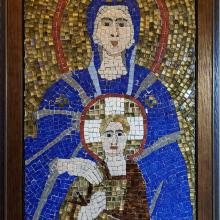In 2013, I had the pleasure to visit the Hagia Sophia in Istanbul (see picture in this submission) and see the amazing byzantine mosaics that had been uncovered in the former mosque. The Hagia Sophia was built as a Basilica in 537 during the reign of emperor Justinian. In the 9th century, mosaics were added to reflect the religion at the time. When the Basilica was turned into a mosque around 1750, all of the mosaics were covered over. In 1931, a serious restoration effort took place to uncover these lost mosaics by the Byzantine Institute which we now see the results of today. The mother and child image can be seen in this Apse mosaic and the Comnenus mosaics both found at the Hagia Sophia. The difference between traditional Roman mosaics that dominated Europe and Byzantine mosaics were the use of glass and gold.
The Byzantine era of mosaics was brought on by the use of glass and gold in mosaics. Because glass is lighter and more delicate, it could be used on walls. Previous Roman mosaics were stone and ceramic made for floors. Walls for mosaics had several layers of mortar: lime putty with sand, lime putty with a fibrous material and the final layer would be lime and marble dust. An underpainting would be painted on the wet final layer by an artist and workers pushed the tesserae/tile into following behind the artist. The tesserae/tile was mostly made from pancakes of thick colored glass that was cut with a hot rod into bars. These bars would be cut into smaller pieces with a hammer and hardie. When it comes to the gold tesserae/tile, a layer of thin gold is put between 2 layers of clear glass and fused together. The cut gold tesserae was put at slight angles when setting into the mortar to produce a sparkly look.
Because my mosaic was to be portable in a picture frame, several materials and processes were changed. The original mosaic is attached to a brick wall as a substrate. My substrate is a piece of lightweight Wedi board which is strong and stable. I could not do all 3 layers of mortar which would have cracked when my mosaic was moved in a picture frame. Mosaics weren't meant to be portable in the Byzantine period. I used modern thinset mortar for a 1st layer with no additives and let dry. On top of that, I painted an under painting with a gouache. Since I don't have workers to help me, I put tinted thinset in frosting bags to squeeze out to work on a small area at a time. In that period, the mortar would have been white because of the lime, I chose to tint mine gray to simulate the aged look. For my tesserae/tile, I choose a light weight glass which could be cut with modern nippers instead of the hammer and hardie. I was looking for ways to reduce the weight. When it comes to the gold tesserae, I have not been able to replicate the gold inside 2 layers of clear glass. Instead I used a gold backed glass tile. This is the largest mosaic I've ever made: 2'x4'. To turn my mosaic into an artwork that is portable, I had to use some modern processes and materials stated above. The most difficult aspect, besides the size, were the faces. If I were to do this again, I would start with the faces. I spent hours trying to balance the look of a Byzantine face with big eyes and elongated chin with the modern training I've ad with facial proportions. I ended up attaching tesserae/tile and taking pictures trying to figure out the proportions over and over again.
Byzantine and Modern Greek Studies Volume 30 No.1: Byzantine Glass Mosaic Tesserae: Some Material Considerations, Liz James, Department of Art History, University of Sussex, 2006.
Hagia Sophia, Istanbul: Conservation Techniques for Mosaics video, https://www.youtube.com/watch?v=wHKLNoVBTKA , Length 12:34
Mosaics of the Hagia Sophia: Istanbul- The fossati Restoration and the Work of the Byzantine Institute, Natalia B. Teterianikov, Dumbarton Oaks Publishers, 1998
Mosaic Techniques & Traditions: Projects and Designs from Around the World, Sonia King, Sterling Publishers, New York, 2006.
Roman Mosaic Hammer & Hardie (Hardy), Lawrence Payne, https://www.youtube.com/watch?v=pgsU3goyz4Y , Length 2:27






